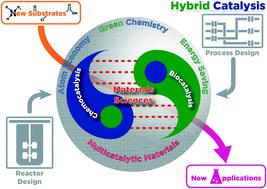当前位置:
X-MOL 学术
›
Catal. Sci. Technol.
›
论文详情
Our official English website, www.x-mol.net, welcomes your
feedback! (Note: you will need to create a separate account there.)
The various levels of integration of chemo- and bio-catalysis towards hybrid catalysis
Catalysis Science & Technology ( IF 4.4 ) Pub Date : 2020-08-27 , DOI: 10.1039/d0cy00696c Egon Heuson 1, 2, 3, 4, 5 , Franck Dumeignil 1, 4, 6, 7, 8
Catalysis Science & Technology ( IF 4.4 ) Pub Date : 2020-08-27 , DOI: 10.1039/d0cy00696c Egon Heuson 1, 2, 3, 4, 5 , Franck Dumeignil 1, 4, 6, 7, 8
Affiliation

|
Combining catalysts is not a recent concept. For several decades, it has enabled the development of processes that are more economical in terms of solvents, energy, and carbon emissions. This strategy leads the way in current catalytic research aiming to reduce the impact of the chemical industry on the environment and replace synthetic routes based on petroleum with those based on biomass. In particular, hybrid catalysis, consisting of the integrated combination of several catalysts of different types, often a chemical and bio-catalyst, represents one of the most promising innovations in the field, especially when the two catalysts are combined in a single multicatalytic material. Several examples of such achievements have already been reported; however, these are rare compared to single-type catalyst combinations. It is important to understand the issues that govern hybrid catalysis to overcome the obstacles affecting its implementation, starting with the difficulties of communication between scientists of different fields. To surmount this barrier, this article proposes a new naming system for multicatalytic processes and reactions to unify common terms describing the same concepts. This system allows for the comparison of multicatalytic systems developed in both chemistry and biology and highlights their differences, similarities, and limitations. Hybrid catalysis is a rapidly expanding interdisciplinary field that builds on the developments from both the field of catalysis and materials science. Although the number of synthetic examples is limited, they are growing exponentially using the latest innovative materials for the production of multicatalytic materials for use in optimized “one-pot/one-step” processes.
中文翻译:

化学和生物催化向混合催化的不同整合程度
结合催化剂不是最近的概念。几十年来,它使开发在溶剂,能源和碳排放方面更经济的方法成为可能。该策略在当前的催化研究中处于领先地位,旨在减少化学工业对环境的影响,并将基于石油的合成路线替换为基于生物质的路线。特别是,混合催化由几种不同类型的催化剂(通常是化学和生物催化剂)的整体组合组成,是该领域最有希望的创新之一,特别是当两种催化剂组合在一种多催化材料中时。已经报道了这种成就的几个例子;然而,与单一类型的催化剂组合相比,它们很少。重要的是要理解控制混合催化的问题,以克服影响其实施的障碍,首先要解决不同领域的科学家之间的沟通难题。为了克服这一障碍,本文提出了一种用于多催化过程和反应的新命名系统,以统一描述相同概念的通用术语。该系统可以比较化学和生物学领域开发的多催化系统,并突出显示它们的差异,相似性和局限性。混合催化是一个快速发展的跨学科领域,它建立在催化领域和材料科学领域的发展基础上。尽管合成示例的数量有限,
更新日期:2020-09-02
中文翻译:

化学和生物催化向混合催化的不同整合程度
结合催化剂不是最近的概念。几十年来,它使开发在溶剂,能源和碳排放方面更经济的方法成为可能。该策略在当前的催化研究中处于领先地位,旨在减少化学工业对环境的影响,并将基于石油的合成路线替换为基于生物质的路线。特别是,混合催化由几种不同类型的催化剂(通常是化学和生物催化剂)的整体组合组成,是该领域最有希望的创新之一,特别是当两种催化剂组合在一种多催化材料中时。已经报道了这种成就的几个例子;然而,与单一类型的催化剂组合相比,它们很少。重要的是要理解控制混合催化的问题,以克服影响其实施的障碍,首先要解决不同领域的科学家之间的沟通难题。为了克服这一障碍,本文提出了一种用于多催化过程和反应的新命名系统,以统一描述相同概念的通用术语。该系统可以比较化学和生物学领域开发的多催化系统,并突出显示它们的差异,相似性和局限性。混合催化是一个快速发展的跨学科领域,它建立在催化领域和材料科学领域的发展基础上。尽管合成示例的数量有限,































 京公网安备 11010802027423号
京公网安备 11010802027423号